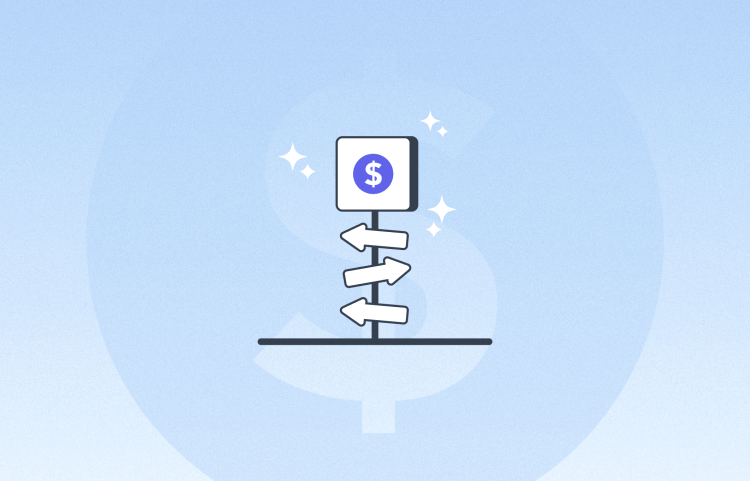
The Ultimate 2021 Guide to Profitable Amazon Sponsored Brands Ads
Zoë MacDonald, March 31, 2021
Table of Contents
Part A: Amazon Sponsored Brands FAQ
What’s the difference between Sponsored Products and Sponsored Brands?
How do I choose product groupings for Amazon Sponsored Brands?
Part B: Amazon Sponsored Brands PPC Strategy
What’s next: tips and advanced techniques for Sponsored BrandsConclusion and key takeaways
What are Amazon Sponsored Brands?
Sponsored brand is a PPC ad designed to increase visibility of your brand among customers shopping for products like yours. These ads appear in Amazon search results and feature your brand logo, a custom headline, and multiple products.
Looking for more Amazon PPC background, data, and insights?
Whether you’re interested in a high-level analysis of Amazon Advertising, a detailed look at recent marketplace trends, or a deep dive into the nuances of specific product categories, our 2022 Amazon Advertising Benchmark Report can help you gain insight into the Amazon PPC landscape.
The report is based on a comprehensive analysis of over 2 million Sponsored Products campaigns and you can download it for free today.
Why should I use Amazon Sponsored Brands?
There’s a rumor circulating about Sponsored Brands: That they’re for upper-funnel advertising. And that’s true! They’re effective at building brand awareness on Amazon.
But, if you’re at the stage in your Amazon eCommerce journey where you’re focused on increasing sales and profitability only – it’s still a good idea to invest in Sponsored Brands.
In fact, in some cases, Sponsored Brands perform even better than Sponsored Products – due, in part, to their strong CTR.
RoAS for Sponsored Brands is 18% higher than Sponsored Products'
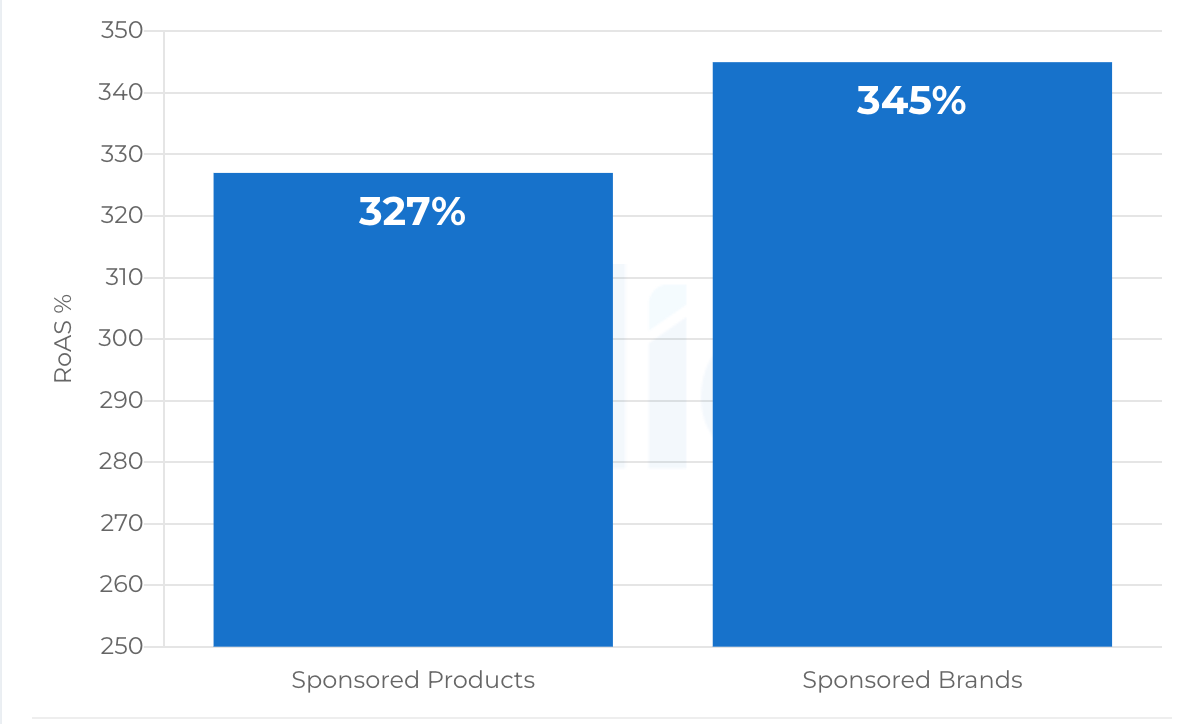
Source: Sellics study conducted in Q3 2020 comparing median-performing Sponsored Brands and Sponsored Products Amazon PPC ads.
It bears repeating: Amazon Sponsored Brands can be an effective performance, i.e. “low funnel” format. And yet, most sellers and vendors (72%) do without.
Top sellers use cutting-edge advertising tools
Perpetua offers the most advanced Amazon PPC solution on the market, with all the tools, resources, and expert support you need to build successful campaigns for your products. And what’s more, it couldn’t be easier to get started. Request a free demo today to discover the industry’s premier optimization and intelligence software for Amazon Ads.
With richer content options, Sponsored Brands can also be a more persuasive way to attract new customers to your product and brand. The opportunity to direct traffic to stores not only provides a better shopping experience, but ushers potential customers to the only place on Amazon where your competitors can’t purchase ad real estate. And, that’s likely to increase conversions.
In case your hesitation is borne of uncertainty, we’re here to help! Based on hard-won expertise and data analysis, we’ve developed a beginner’s strategy that’s easy to implement and optimized for maximum return.
We’ve written this guide under the assumption that you’re already familiar with PPC basics, having some experience implementing Sponsored Products. If that’s not the case, start here.
Are you an early adopter of Sponsored Brands - or are they already common in your category?
Use the Benchmarker Tool to find out.
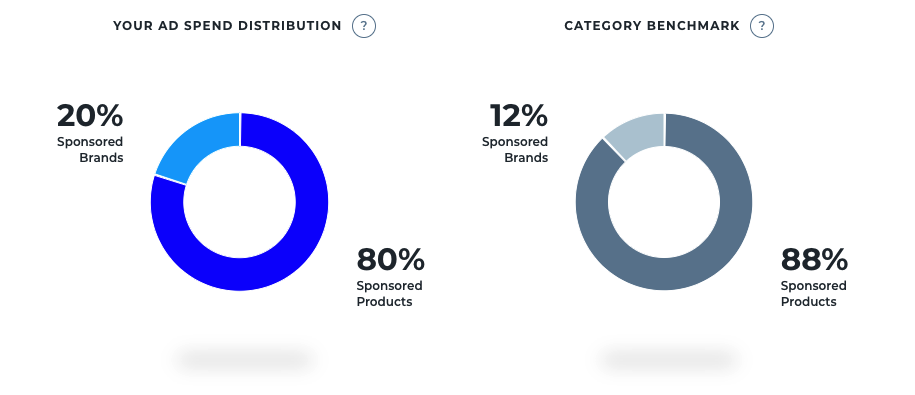
Amazon Sponsored Brands Formats
There are 3 formats of these keyword and (sometimes) ASIN-targeted ads: Product Collection (the original), Store Spotlight, and Video.
FORMAT | PRODUCT COLLECTION | STORE SPOTLIGHT | VIDEO |
|---|---|---|---|
Placements | Top of search Product detail page Search footer | Top of search Search footer | Within search results |
Landing pages | 1 Amazon store or store sub-page Custom landing page (with 2+ in stock products) Product Detail Pages | Amazon stores and store sub-pages | Product Detail Page |
Maximum number of products displayed (at one time) | 3 | 3 (as storefronts) | 1 |
Logo and brand name | Yes | Yes | No |
Custom creative | Product selection and order Headline Custom image | Store pages and order Displayed (store) images Displayed (store) names | Video |
Keyword targeting | Yes | Yes | Yes |
Product (ASIN and Category) targeting | Yes | Yes | Yes |
Let’s dig in to each in a bit more detail.
Product Collection Sponsored Brands

Product Collection Sponsored Brands - Top of search placement
Product Collection ads highlight three products at a time. Both the product selection and the order is up to you.
For the moment, you can also opt in to ‘product optimization’ – making this selection dynamic, however, Amazon will be sunsetting this feature shortly.
Assuming you’re starting from scratch content-wise, Product Collection ads are the quickest to implement: you only need to write a headline.
You’ll notice the ad above also shows a custom image - this option is currently in beta but likely to stick around. It’s wise to use one – an Amazon study suggests that adding custom (lifestyle) creative can increase CTR by between 20 and 30%.
Top sellers use cutting-edge advertising tools
Perpetua offers the most advanced Amazon PPC solution on the market, with all the tools, resources, and expert support you need to build successful campaigns for your products. And what’s more, it couldn’t be easier to get started. Request a free demo today to discover the industry’s premier optimization and intelligence software for Amazon Ads.
If you don’t happen to have suitable lifestyle images, don’t force it: you can publish the ad without the additional content and it’s better to leave more to the imagination than to publish a subpar image that could damage your brand.
Both Product Collection Sponsored Brands and Store Spotlight ads may also appear at the bottom of the search under the heading “Brands related to this search”. In that case, they look like this:

Product Collection and Store Spotlight Sponsored Brands - Search footer placement
On the Product Detail Page, you can identify Sponsored Brands by their unique features: a headline, logo, or both. You should know that by the end of the month, all static Sponsored Brands ads will require a logo.
Best practices for Product Collection Sponsored Brands
Invest in a high-quality lifestyle image that shows your product in the best light possible.
Take the time to craft a clickable headline. Get creative! Think about what shoppers love most about your product. Of course, make sure you’ve covered the basics:
Use sentence case
Keep it relevant
Consider including a CTA
But, don’t add pressure: emotionally charged language like “don’t wait, buy now!” is prohibited.
When in doubt, describe - like above “Styles for every growing kid who likes to skate.”
Experiment with product selection and order. If you have a ‘star’ product, consider featuring it in related groups to draw attention to the ensemble.
If you have a brand store, try linking to it to improve your RoAS: Remember, you can use sub-pages too for more precision.
Keep an eye on your stock. Because your ads will keep running even if you’re out of one of the featured products, they should be paused manually.
Start by targeting specific or long-tail product keywords to serve performance (sales and profit) goals.
Store Spotlight Amazon Sponsored Brands

Store Spotlight Sponsored Brands - Top of search placement
Store Spotlight Sponsored Brands are similar to Product Collection ads - except that they feature stores instead of products.
The best reason to build a brand store is that it’s the only place on Amazon where your competitors can’t purchase real estate. This, combined with an improved shopping experience is likely why an Amazon study revealed that linking to a store increases RoAS by 29% - compared to a Product List page.
Top sellers use cutting-edge advertising tools
Perpetua offers the most advanced Amazon PPC solution on the market, with all the tools, resources, and expert support you need to build successful campaigns for your products. And what’s more, it couldn’t be easier to get started. Request a free demo today to discover the industry’s premier optimization and intelligence software for Amazon Ads.
Stores work well for brands with a large selection of products, but aren’t limited to them. They can be segregated by: product type, use case, style, theme, age group, and more. In addition to showcasing the products, they can also highlight their unique features with rich, custom, inspirational or educational content.
Best practices for Store Spotlight Sponsored Brands
Invest resources in building engaging brand stores - with high quality content.
Just like Product Collection ads, you want your headline to encourage a click. This time, keep in mind that you’re inviting someone into your shop: Try opening with inviting and positive language, like “Explore”, “Encourage”, “Create”, or “Shop”, “Visit”. Or, be more bold by using a brand tagline and let the store descriptions do the talking.
Experiment with featured (store) images, display names, and their order.
Start by targeting generic or branded keywords to capture an audience willing to browse - fostering brand awareness and loyalty.
Sponsored Brands Video
One way to think about Sponsored Brands Video on Amazon is that they’re super Sponsored Products: they only advertise one product at a time and link directly to the product detail page.
If you have video collateral featuring one of your best sellers, you should absolutely consider investing in this format.
According to an Amazon study, Sponsored Brands Video have a CTR 2x higher than static Sponsored Brands and average between 28-43% higher RoAS than Sponsored Brands Product Collection ads.
Best practices for Sponsored Brands Video
Prioritize your top-sellers, taking into account the products’ suitability for rich content. Ask, can the video inspire or educate?
Don’t ‘tease’ the product - get to the point, showing the product in the first couple seconds.
Keep it short and sweet, between 15 and 30 seconds. And, consider that the video will play on a loop.
Don’t rely on sound. Use closed captions that agree with Amazon’s guidelines, and use onscreen text where relevant. Since the default is ‘mute’, it’s likely to stay that way.
Like product images, your video should be well-lit, high-resolution, and overall polished and professional-looking. If you don’t have in-house resources for video creation, consider getting Amazon’s help.
Channel positivity. Don’t slam the competition. Focus on the product’s value without highlighting the problem it’s solving - this isn’t an infomercial.
Avoid wasting time and resources by paying close attention to Amazon’s specs. If not, your campaign risks being rejected.
Start by targeting specific keywords to increase sales and profit for top sellers. Next, branch out to generic and brand keyword targeting to achieve brand awareness.
Where do Amazon Sponsored Brands appear?
Like Sponsored Products, Sponsored Brands are for advertising Amazon products - on Amazon only. They occupy the coveted top-of-search placement, and can also appear within search results, below search results, or on the Product Detail Page.
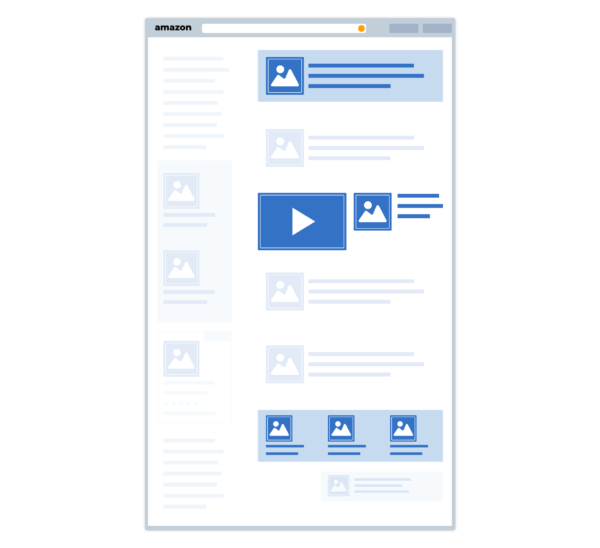
Sponsored Brands search results placements
What’s the difference between Sponsored Products and Sponsored Brands on Amazon?
Besides the format and placements, you’ll notice a few differences when you’re setting up your campaigns.
There are no ‘automatic’ campaigns and no ad groups.
You don’t have to own the buy box to run Sponsored Brands
In addition, you’ll find:
a chance to include creative components - from a simple headline phrase to a video, Sponsored Brands are more customizable
the ability to link to multiple products: using a custom landing page or brand store - including sub-pages.
new-to-brand metrics! A super useful metric that lets brands know whether ad-attributed purchases were made by new or an existing customer.
a longer (fourteen day) attribution window - rather than seven for Sponsored Products.
attributed sales are reported on the date of the purchase - rather than on the date of the click for Sponsored Products
attributed sales include all sales of products with the same brand, independent of the product being sold by you, Amazon or a third party.
Top sellers use cutting-edge advertising tools
Perpetua offers the most advanced Amazon PPC solution on the market, with all the tools, resources, and expert support you need to build successful campaigns for your products. And what’s more, it couldn’t be easier to get started. Request a free demo today to discover the industry’s premier optimization and intelligence software for Amazon Ads.
Who is eligible to purchase Sponsored Brands ads?
To use Amazon Sponsored Brands, you must:
have a true brand logo
be able to ship to all US addresses
sell products from an eligible category
have a minimum of three products of the same brand (one product for Sponsored Brands Video)
How do I choose product groupings for Amazon Sponsored Brands?
Your product mix will depend on your target keywords/ASINs and format - which will be determined by your strategy. We’ll get into this in more detail in the next section.
For all Sponsored Brands, we recommend focusing on high-performing products with a history of buy-box ownership, likely meaning they can compete on both:
reviews (both star rating and volume), and
price
Otherwise, your rich content could end up generating sales for your competitor.
How much should I spend on Sponsored Brands?
For starters, consider dedicating 20% of your Amazon Ad budget to Sponsored Brands - with the remaining 80% going to Sponsored Products. How much the campaigns will cost is a different question, as CPCs vary widely by category and marketplace.
What are the CPCs like in your product category?
Try the free Benchmarker to compare budgets, CPCs and ACoS of competitors in your category, subcategory (over 20,000!), and marketplace.
PPC Strategy: Use Sponsored Brands to Drive Sales and Increase Profit on Amazon
Step 1: harvest top-performing keywords from your Sponsored Products campaigns
Your Sponsored Products campaigns are an invaluable resource on Amazon! If you’re familiar with our recommended strategy (or the advanced version) then you’ll notice we recommend harvesting targets from Sponsored Products to use for both Sponsored Brands and Sponsored Display.
You want to harvest only your best-performing - meaning highest-converting - keywords. That’s because you want to give your Sponsored Brands campaigns the best chance at success by targeting (only) tried and tested keywords.
If you’ve structured your campaigns according to our suggestion, the harvesting process will be simple: Select targets from your exact match campaigns.
Top sellers use cutting-edge advertising tools
Perpetua offers the most advanced Amazon PPC solution on the market, with all the tools, resources, and expert support you need to build successful campaigns for your products. And what’s more, it couldn’t be easier to get started. Request a free demo today to discover the industry’s premier optimization and intelligence software for Amazon Ads.
What’s harvesting?
If you said “huh?” when we said harvesting, get the details here.
For the beginner strategy, you only need to harvest specific keywords. For our advanced recommendation, you’ll need all three.
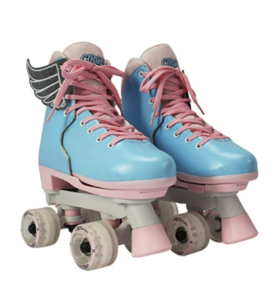
Source: Amazon.com
TYPE OF KEYWORD | CHARACTERISTICS | (LIKELY) SEARCHER INTENT | EXAMPLE |
|---|---|---|---|
Specific keywords | – Also called “long-tail” keywords – Include more words for specificity (usually more than 3) – Low search volume – less competitive | Searcher knows what they want More likely to be ready to buy (low funnel) | Vintage looking pink roller skates |
Generic keywords
| – Also called “fat-head” or “category” keywords – Usually few keywords, which are generic – could apply to many products – High search volume – competitive | Searcher does not yet know exactly what they want More likely to be willing to browse and not ready to make an immediate purchase Likely to be brand agnostic | Roller skates |
Brand keywords | – Includes your brand | Searcher expressing an interest in (at least awareness of) your brand | Circle City roller skates |
Don’t have enough high-performing keywords in your Sponsored Products campaigns to harvest?
Use Sonar, the free keyword research tool that uses search terms from Amazon by marketplace.
Step 2: setting up your first Amazon Sponsored Brands campaign
This is the right set-up for you if:
You have little to no brand recognition, a small (less than 10) number of products, and few (or no) creative assets and your (only) goal on Amazon is increasing sales and profits.
We’re starting with the lowest hanging fruit: using Sponsored Brands as an accompaniment to Sponsored Products to increase sales and profits.
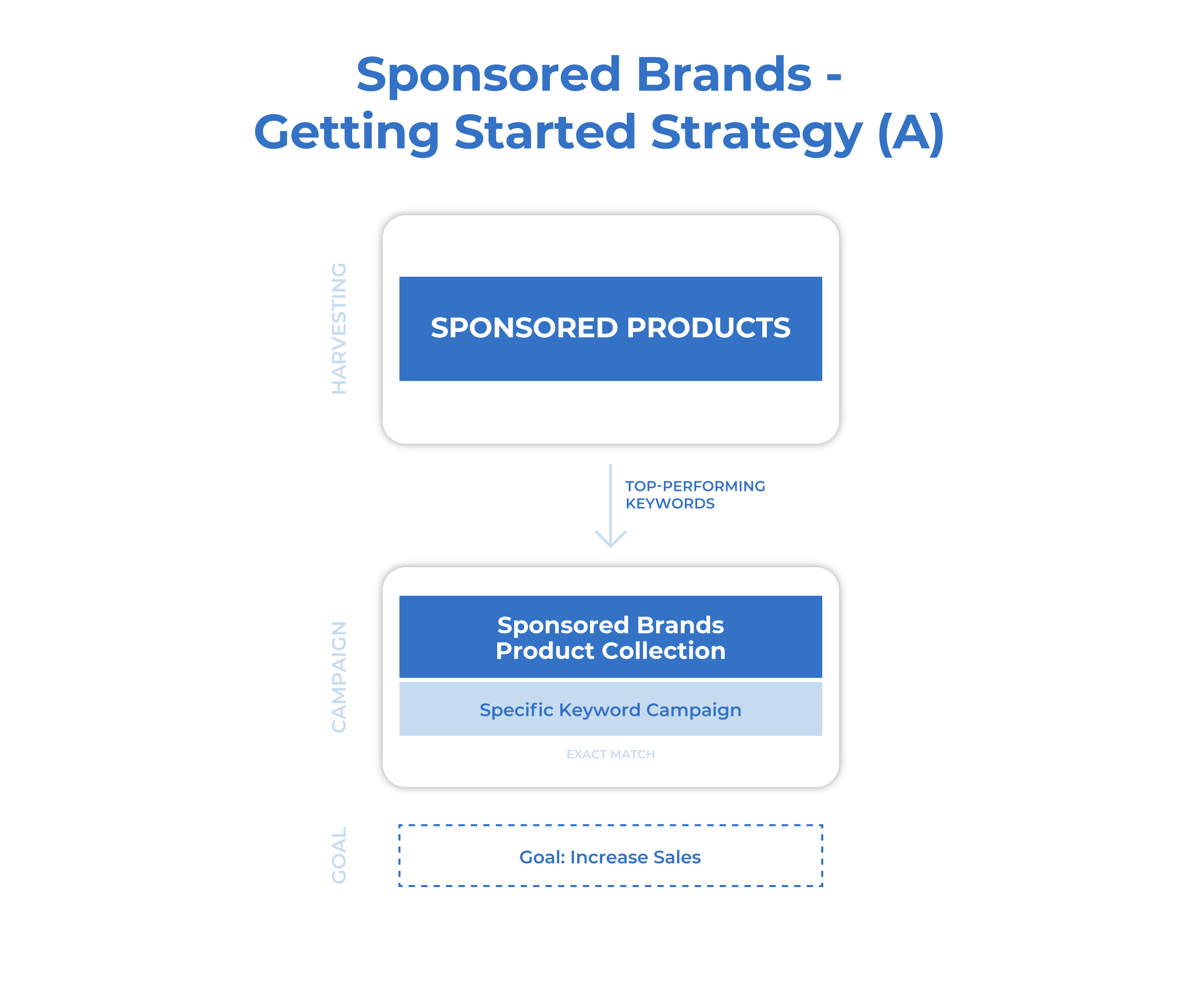
From your high-performing/best selling products create groupings that share similar keywords.
For each product grouping, create one Sponsored Brands Product Collection campaign, use exact match targeting with the specific keywords that you harvested from your Sponsored Products campaigns.
This strategy is suitable for anyone eligible and interested in Sponsored Brands. It’s quick and easy to set-up and is likely to have a higher return because you’re only bidding on already-optimized keywords.
Alternatively: research relevant keywords with Sonar.
As far as set-up goes, you can stop here. If you’re following the ‘getting started strategy’, then skip right to optimization.
Top sellers use cutting-edge advertising tools
Perpetua offers the most advanced Amazon PPC solution on the market, with all the tools, resources, and expert support you need to build successful campaigns for your products. And what’s more, it couldn’t be easier to get started. Request a free demo today to discover the industry’s premier optimization and intelligence software for Amazon Ads.
Unless: you have a suitable video or the ability to create one. Because videos are low funnel (remember, super Sponsored Products) and because video-format ads tend to perform better across the board, you should invest if you can.
In that case, your starter set-up will look like this:
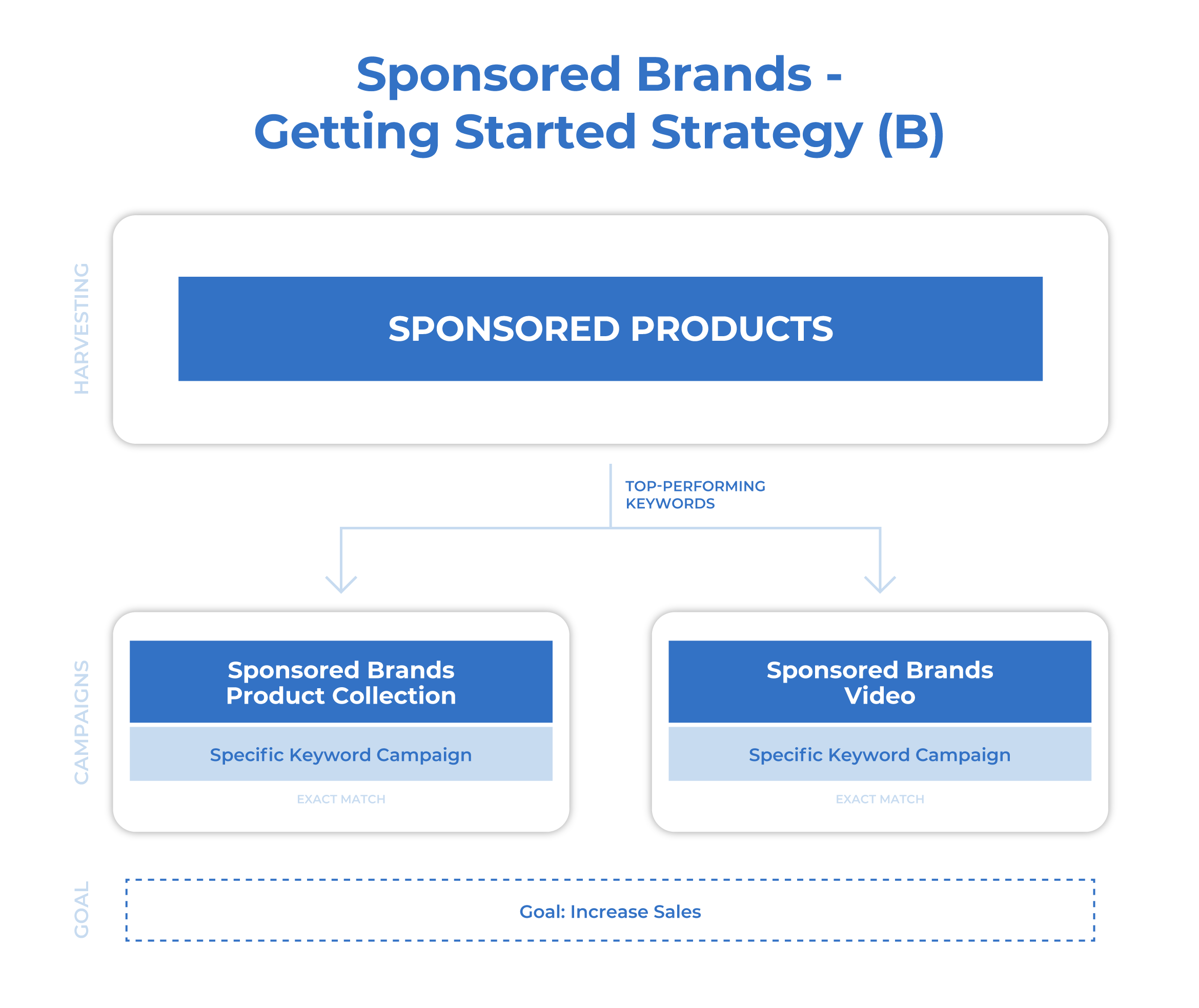
Unlike your Sponsored Brands Product Collection ads, your Sponsored Brands Video ads will feature just one product. That means you’ll start by setting up one campaign per video.
Video can also be a powerful brand-building tool, but we’ll cover that in more detail in the advanced edition.
For now, your first video campaign should target specific high-converting keywords using exact match that are, of course, specific to the product advertised - as opposed to the grouping in the Product Collection version.
With your PPC strategy growing evermore powerful, it’s only a matter of time before Amazon shoppers are taking notice of your brand - even including it in search terms.
At that point, it’s a good idea to capitalize on the attention and use it to grow to the next level, incorporating more advanced goals into your set-up
Step 3 – level up: advanced Amazon Sponsored Brands structure and setup
This is the right set-up for you if:
you have some (or a lot) of brand recognition already, more than 10 products, and you either have an inventory of creative assets or the resources to make them. In addition to increasing sales and profit, you’re beginning to incorporate brand (upper funnel) goals to chart a path for long term growth on Amazon.
Building brand recognition on Amazon is something you should nurture as it can set off a virtuous cycle, encouraging long term success on the platform.
That’s why, in our advanced set-up, we’re including advanced goals: brand awareness, defense, and loyalty.
Brands coming to the format with already strong recognition should consider starting here - especially if you’re equipped with a lot of creative content or the resources to create it.
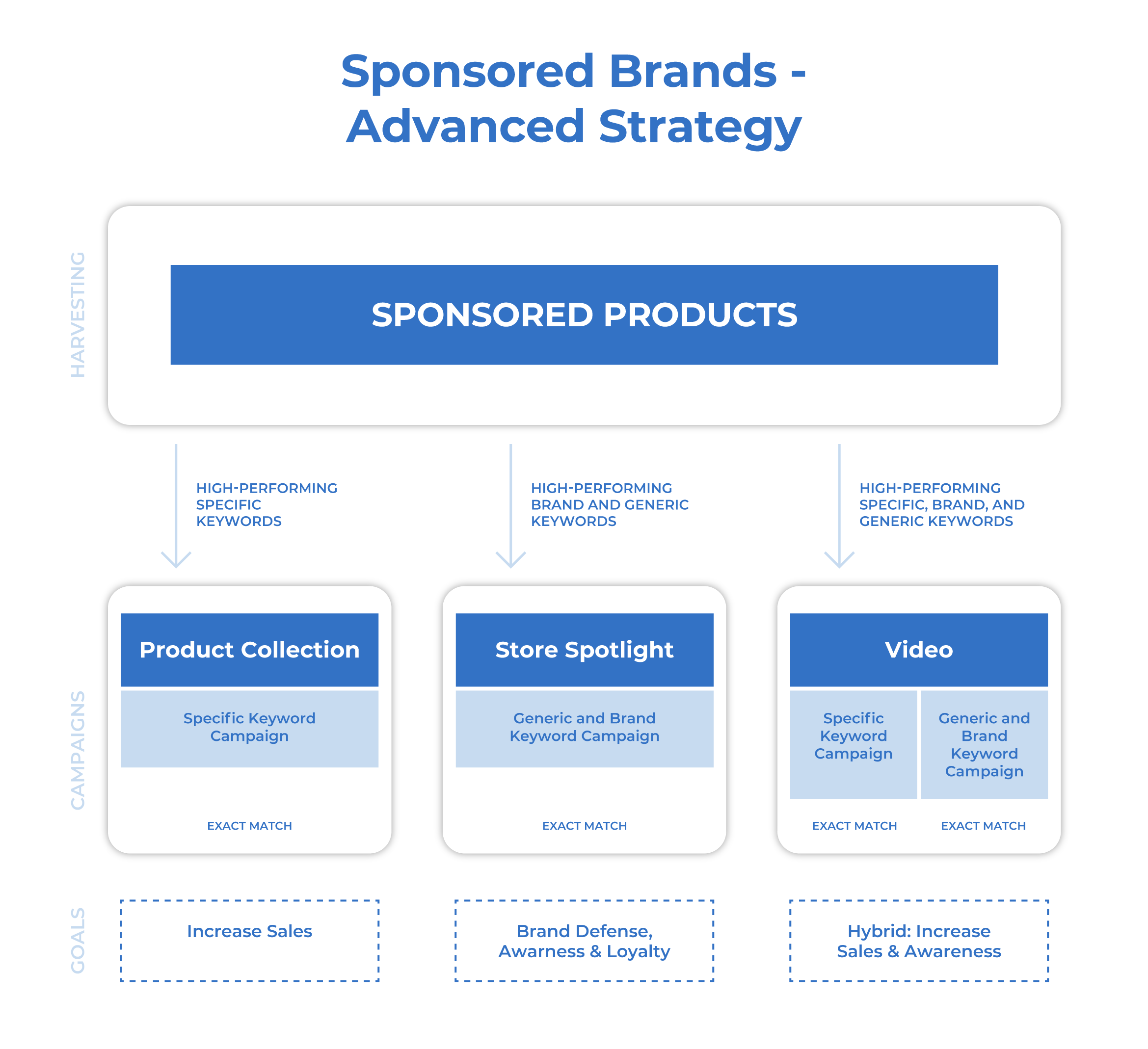
In addition to the two campaigns from step 2, create two more using brand and generic keywords this time, once again harvested from Sponsored Products campaigns.
1 campaign for Store Spotlight ads (with brand and generic keywords)
1 campaign for Video ads (with brand and generic keywords)
“Generic” keyword searchers and “brand” keyword searchers are likely to have something in common: a willingness to browse.
That’s why Store Spotlight makes a good fit for both audiences. Though, if you do have the time, each could warrant their own campaign.
In both cases, whether you’re giving a first impression (generating awareness) or encouraging brand loyalty from a shopper who’s already interested, you want to put your best foot forward (encouraging loyalty), and eliminate distracting ads by your competitors (brand defense).
No stores? No problem!
Top sellers use cutting-edge advertising tools
Perpetua offers the most advanced Amazon PPC solution on the market, with all the tools, resources, and expert support you need to build successful campaigns for your products. And what’s more, it couldn’t be easier to get started. Request a free demo today to discover the industry’s premier optimization and intelligence software for Amazon Ads.
If you want to level up without creating multiple stores, you can implement advanced goals like brand awareness using Sponsored Brands Product Collection ads instead.
In that case, highlight your top-selling products: this is especially likely to work if you have an ‘all-star’ product that is a common entry point to your brand.
Next is adding an upper funnel video campaign. Because of the compelling nature of a video ad, it will draw attention to your brand, generating brand awareness.
You want to get as much mileage from the asset as possible by showing it to browsing audiences who aren’t yet committed to your brand (generic searchers).
And, video ads are likely to impart authority and trust contributing to brand loyalty among brand searchers.
Step 4: optimize your Amazon Sponsored Brands
Target optimization
With our simplified set-up, targets are basically already optimized, because they’re sourced (based on good performance) from your Sponsored Products campaigns.
And because you’re starting with an exact match - you’ll have less work to do on the target pruning side - where you eliminate poor performers. However, you should still monitor the keywords’ performance: it’s possible that what works for one format won’t translate directly to another.
For sales and profit campaigns, use conversions to measure target performance. Because the median conversion rate is about one percent lower for Sponsored Brands, remove targets from sales campaigns when they fail to convert after 20 clicks. (Don’t forget about the fourteen day attribution window.)
For brand awareness campaigns on Amazon, use impressions to find out which keywords are giving you the most exposure and CTR to measure the relevance of those keywords. What’s ‘good’ will depend on your sub-category and marketplace, but the marketplace Benchmark is slightly higher than Sponsored Products’, at 0.37%.
Additionally, keep looking for new converting keywords in your Sponsored Products campaigns to add to your Sponsored Brands campaign.
Ready for new matches?
Once you get the hang of managing your Sponsored Brands campaigns, consider trying broad match - that will give Amazon some flexibility to find new and potentially profitable search terms.
However, to avoid blending generic and specific keywords, you will have to monitor your broad match search terms closely and be prepared for more “pruning”.
Top sellers use cutting-edge advertising tools
Perpetua offers the most advanced Amazon PPC solution on the market, with all the tools, resources, and expert support you need to build successful campaigns for your products. And what’s more, it couldn’t be easier to get started. Request a free demo today to discover the industry’s premier optimization and intelligence software for Amazon Ads.
Bid optimization
Optimizing your bids means making sure that your ad spend agrees with your advertising goals.
For maximizing sales or brand awareness use a break-even ACoS.
Goal is maximizing sales/impressions:
ACoS target value = ’break-even ACoS’ = profit margin before ad spend
For generating sales while achieving a profit define your target ACoS.
Goal is generating profit:
ACoS target value = ‘target ACoS’ = profit margin before ad spend – target profit margin after ad spend
Because bid optimization depends on CTR, conversion rate, and bid competition ($), it should happen on the target-level. Start with Amazon’s suggested bid and make adjustments from there.
When keywords meet break-even / target ACoS | Do nothing | = |
When keywords exceed break-even / target ACoS | Consider decreasing your bid | ⌄ |
When keywords are below break-even / target ACoS | Increase your bid | ^ |
Caution: ACoS isn’t the end-all-be-all for Sponsored Brands
According to an Amazon study, only 4% of shoppers convert to purchase immediately.
That means your ads are likely to have influence beyond the attribution window - especially as Amazon uses the ‘last touch’ model: Your client could have decided to purchase based on browsing your store, but when it came time to buy, they clicked on your Sponsored Product ad from search results.
That’s why we say Sponsored Products and Sponsored Brands are better together - and why ACoS isn’t always the best metric for Sponsored Brands.
For brand campaigns, consider new-to-brand metrics: how much would you pay for a new customer? If the answer is more than your product margin, consider a higher than break-even ACoS for those campaigns.
Content optimization
When we talk about optimization, we mean different levers that you can pull to effect changes that improve your ad campaigns.
For Amazon Sponsored Brands, this goes beyond simple listing optimization because the ads themselves incorporate custom content. This is a unique opportunity not afforded by any other platform ad format.
And with stores and custom pages, you even have more control over creating your landing pages. You might as well make the most of it.
Here are the factors that can be tested, improved, and optimized for the static Sponsored Brands formats (Product Collection and Store Spotlight):
CONTENT | MEASURED BY |
|---|---|
Product/store selection Product/store order Images (lifestyle, products, storefronts) Headline | Click-through-rate |
Landing page content (custom pages, Product Detail page, stores and sub-pages) | Conversion rate |
First, follow the best practices we recommended in the first section.
Then, to truly ‘optimize’ these pieces, especially those measured by click-through-rate, we recommend running A/B tests.
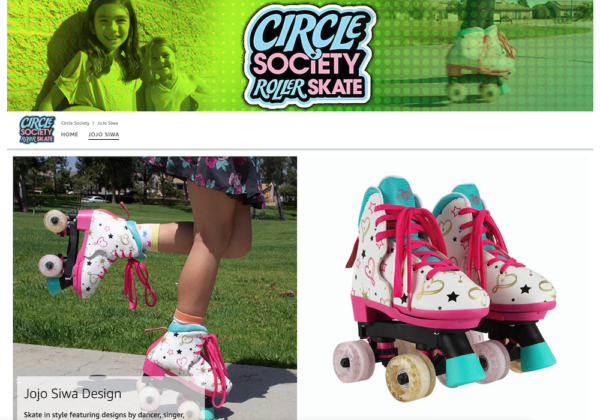
Store Spotlight landing page | source: Amazon.com
Step 5: benchmark your progress on Amazon
How does my Sponsored Brands performance compare to my direct competitors’?
To find out how you’re doing, you need to be able to put your KPIs in context: Not just ‘on Amazon’, but within your own sub-category, marketplace, and according to the Sponsored Brands ad format.
Use the (free) Benchmarker Tool to find out how your:
ACoS
CPC
Click-through-rate, and
Conversion rate
compare to your closest competitors’.
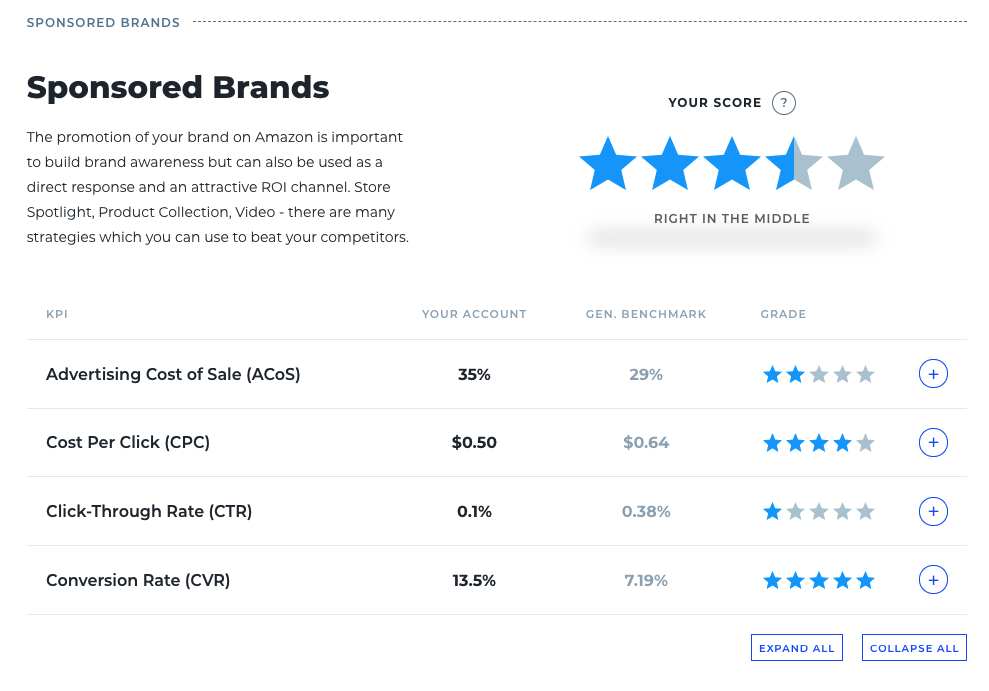
Because what gets measured gets managed, you’ll be one step closer to improving your account: you’ll even find customized tips inside the tool.
Top sellers use cutting-edge advertising tools
Perpetua offers the most advanced Amazon PPC solution on the market, with all the tools, resources, and expert support you need to build successful campaigns for your products. And what’s more, it couldn’t be easier to get started. Request a free demo today to discover the industry’s premier optimization and intelligence software for Amazon Ads.
What’s next: tips and advanced techniques for Sponsored Brands
1. Add ASIN targeting to your Sponsored Brands campaigns
Start by adding one ASIN-targeted campaign to each format:
For Product Collection, draw from optimized ASINs from Sponsored Products.
For Store Spotlight, use category targeting to increase exposure to your brand quickly and drive more traffic to your store.
At this time, ASIN targeting is not available for Sponsored Brands Video.
2. Use Sponsored Brands to support marketing campaigns
There are a myriad of ways that Sponsored Brands can be used to boost situational marketing campaigns during deal days, promotions, seasonal shopping, and for product launches.
For example: consider creating a Store Spotlight Sponsored Brands campaign in Q4 highlighting stores with a ‘gift guide’ theme for your target demographic.
3. A/B test your Sponsored Brands content
A/B testing means running two campaigns simultaneously with only one variable changed so that you can properly test which version is more effective. Start with your headlines - measuring the difference in CTR to determine the winner.
4. Match your Sponsored Brands headline closely to keywords
Using either Sponsored Products campaigns or a broad match Sponsored Brand campaign for research and screen search terms for high-volume phrases with a good conversion rate.
Then, create a dedicated Sponsored Brands campaign targeting those related keywords with a headline matching that exact phrase or incorporating the most common adjectives.
5. Try placement modifiers
Increase or decrease your bid for placements other than Top of Search by up or down 99% to select the placement that works best for your brand.
Amazon Sponsored Brands: conclusion and key takeaways
Now that we covered the what, why, and where of Sponsored Brands, all that’s left is the ‘when’ - to which we’d gently suggest now.
With your Sponsored Products campaigns down, incorporating Sponsored Brands is your best next step in building a PPC strategy that promises to increase sales and build brand recognition on Amazon, carving a path for long term growth.
We’ve broken it down to five simple steps – where you can choose the level of investment that’s right for you, i.e. step three is skippable.
Harvest top-performing keywords from your Sponsored Products campaigns
Level up: Incorporate an advanced Sponsored Brands structure and setup
And whether you decide to start with the basics or to implement an advanced structure, we’re here to help.
To check in on your own progress along the way, try the (free) Benchmarker Tool to measure your KPIs against your peers in your sub-category.
As always, we’re invested in your success so keep us posted on your progress and please feel free to post comments and questions below!
To get started or learn more about how Perpetua can help you scale your Amazon Advertising business, contact us at hello@perpetua.io